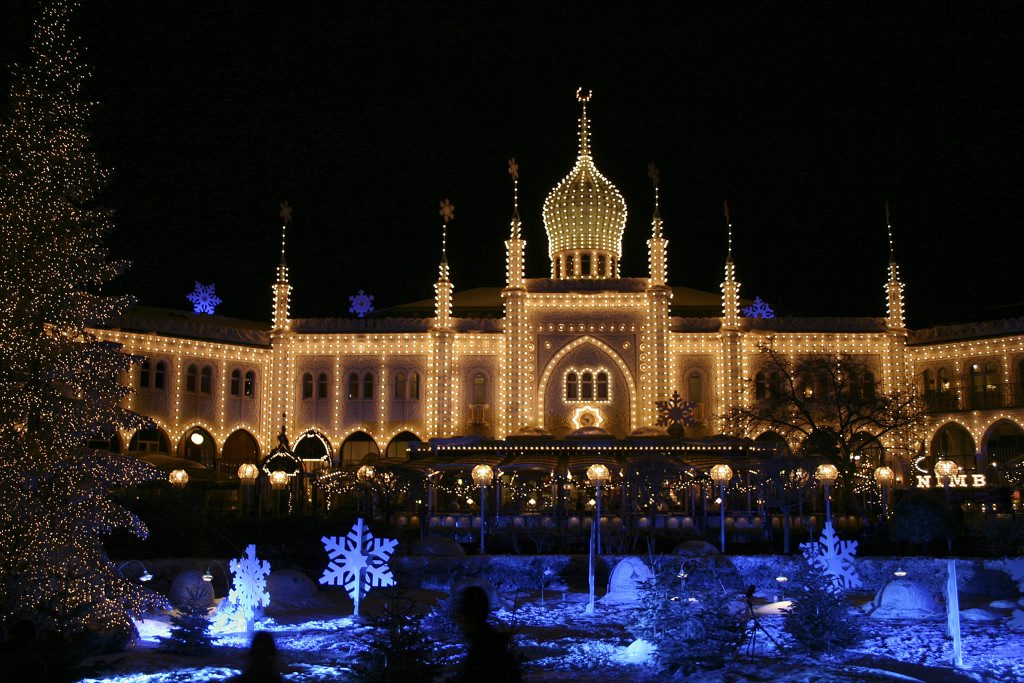
Scandinavian Kingdom of Denmark, which still preserves traces of its Viking past, is the smallest and southernmost of the Nordic countries. Its only land border is shared with Germany and, from the late’90s, is connected to Sweden by the Oresund Bridge and bounded on the north by Norway. Also belong to the Danish territory overseas Greenland and the Faroe Islands.
Climate:
Despite being one of the Nordic countries, Denmark’s climate is extremely cold, but unstable. The winter is characterized by being cold and cloudy, with snow from January to March. Summers are relatively hot and sunny. In Copenhagen, the temperature ranges from -3 º C in winter and 22 º C in summer. Rain is frequent throughout the year but are most abundant between August and October. The best time of year to visit the country during May and June, when the landscape is in its full glory and the weather is pleasant. While in autumn the fields are less colorful, the weather is still good and a visit to Denmark can be pleasant.
Important Information:
For most Western countries, including Australia, Canada, USA, New Zealand, Malaysia, Singapore and the EU and South America, the only requirement is to visit Denmark for a passport valid for 6 months from the date of arrival.
The official currency is the Danish krone (DKK). Throughout the country there are many ATMs and credit cards, especially Visa, are widely received. In banks and hotels can be easily change traveler’s checks, there are also several official exchange offices that work until the evening seven days a week.
Security conditions in Denmark are good and the crime rate is low. However, during the peak season usually common theft in the areas most frequented stations and trains, so it is recommended to be careful with your luggage and valuables.
Where to go?
The attractive city of Copenhagen, capital of the country and largest city, its skyline is made up of six buildings among which the needles of the churches and a couple of hotels. The main centers of cultural and historical interest are concentrated in a small space, while the rest of the city is adorned by beautiful gardens, fountains, plazas and parks. In the east of the square you can visit the amusement park Tivoli, which dates from 1843, and in front of him, the central square of the city, Rådhuspladsen. North of the Nyhavn canal, together with the main square of the longest pedestrian street in the world (Strøget street), is the palace of Amailenborg, consisting of 4 identical rococo mansions and home to the royal family since 1794, there can be witness the changing of the guard or visit the museum. The most important churches are the cathedral, Vor Frue Kirke Kirke and Vor Frelsers, located in the area Chistianshavn, whose tower you can climb the spiral. Another good option is to visit the Museum of Copenhagen, famous for its collection of Greek art, Etruscan, Roman and Egyptian, and Nationalmuseet, where you can enjoy an extensive collection of artefacts from the country that extends from the Late Paleolithic to 1840. A visit to this city or Denmark can not be complete without a visit out of the Little Mermaid statue, located on the waterfront, 10 minutes north of the city.

Ribe, the oldest of the Scandinavian cities, dates from before the eleventh century. Some of the places worth visiting are the cathedral there, which tower 27 meters. height, you can enjoy a fantastic view of the city, the gigantic museum of medieval and Viking Ribes Vikinger; the Vikingecenter, which recreates the life of communities Viking.

The famous Legolandia, located on the Jutland peninsula, 1 km from the village of Billund, a theme park is built with giant pieces of the legendary game.
Aarhus, vibrant university town and cultural center of Jutland, had some of the most important musical and theatrical offerings in Denmark. Located in the old town, Den Gamle By, an outdoor museum of 75 buildings, is the main attraction of the city. There is also the largest Danish church, cathedral århus Domkirke, which retains the original Romanesque chapel XII; Vor Frue Kirke church where you can visit the country’s oldest chapel which dates from 1060 and Moesgård Museum, which houses important collections of Iron Age and BONCÓ.
Festivals:
The most important festivals in the country are hundreds of music festivals that take place throughout the year, which have several varieties (gospel, jazz, blues, rock, Irish music, among others). The bonfire night of summer solstice marks the beginning of the season, which highlights the Roskilde Festival, between late June and early July, the biggest rock in northern Europe; Festival Midtfyns (jazz, rock, pop and traditional), in Ringe, in the first days of July. In addition, for ten days in early July, you can attend one of the major jazz festivals in the world, the Copenhagen Jazz Festival, followed by the Copenhagen Summer Festival, which takes place during the last week of July and August and first two shows and classical chamber music.

Another good option is the Tønder Festival in late August, a major traditional music. In September, the first Saturday of the month, beginning on the Aarhus Festival and beyond, the city turns into a festive scene for 9 days, which, in addition to music, you can enjoy theater play, this the festival includes a Viking Festival where you can witness skills of archery, just to see clowns and Viking ships while enjoying traditional food and lots of fun.
Denmark is a very quiet and safe to enjoy.
One Response to “Denmark: The country of the big music festivals in Europe”
Leave a Reply
You must be logged in to post a comment.
mayo 5th, 2009 at 1:10 pm
[…] Denmark: The country of the big music festivals in Europe internet advertising […]